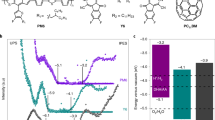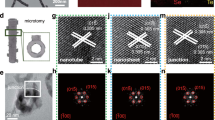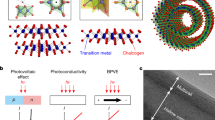Abstract
Understanding the kinetics and energetics of interfacial electron transfer in molecular systems is crucial for the development of a broad array of technologies, including photovoltaics, solar fuel systems and energy storage. The Marcus formulation for electron transfer relates the thermodynamic driving force and reorganization energy for charge transfer between a given donor/acceptor pair to the kinetics and yield of electron transfer. Here we investigated the influence of the thermodynamic driving force for photoinduced electron transfer (PET) between single-walled carbon nanotubes (SWCNTs) and fullerene derivatives by employing time-resolved microwave conductivity as a sensitive probe of interfacial exciton dissociation. For the first time, we observed the Marcus inverted region (in which driving force exceeds reorganization energy) and quantified the reorganization energy for PET for a model SWCNT/acceptor system. The small reorganization energies (about 130 meV, most of which probably arises from the fullerene acceptors) are beneficial in minimizing energy loss in photoconversion schemes.
This is a preview of subscription content, access via your institution
Access options
Subscribe to this journal
Receive 12 print issues and online access
$259.00 per year
only $21.58 per issue
Buy this article
- Purchase on Springer Link
- Instant access to full article PDF
Prices may be subject to local taxes which are calculated during checkout




Similar content being viewed by others
References
Bindl, D. J., Wu, M.-Y., Prehn, F. C. & Arnold, M. S. Efficiently harvesting excitons from electronic type-controlled semiconducting carbon nanotube films. Nano Lett. 11, 455–460 (2011).
Umeyama, T. et al. Carbon nanotube wiring of donor–acceptor nanograins by self-assembly and efficient charge transport. Angew. Chem. Int. Ed. 50, 4615–4619 (2011).
Umeyama, T. et al. Selective formation and efficient photocurrent generation of [70]fullerene–single-walled carbon nanotube composites. Advanced Mater. 22, 1767–1770 (2010).
Arnold, M. S. et al. Recent developments in the photophysics of single-walled carbon nanotubes for their use as active and passive material elements in thin film photovoltaics. Phys. Chem. Chem. Phys. 15, 14896–14918 (2013).
Guillot, S. L. et al. Precision printing and optical modeling of ultrathin SWCNT/C60 heterojunction solar cells. Nanoscale 7, 6556–6566 (2015).
Shea, M. J. & Arnold, M. S. 1% solar cells derived from ultrathin carbon nanotube photoabsorbing films. Appl. Phys. Lett. 102, 243101 (2013).
Dowgiallo, A.-M., Mistry, K. S., Johnson, J. C. & Blackburn, J. L. Ultrafast spectroscopic signature of charge transfer between single-walled carbon nanotubes and C60 . ACS Nano 8, 8573–8581 (2014).
Bindl, D. J. et al. Free carrier generation and recombination in polymer-wrapped semiconducting carbon nanotube films and heterojunctions. J. Phys. Chem. Lett. 4, 3550–3559 (2013).
Marcus, R. A. Chemical and electrochemical electron-transfer theory. Annu. Rev. Phys. Chem. 15, 155–196 (1964).
Marcus, R. A. On the theory of oxidation-reduction reactions involving electron transfer. I. J. Chem. Phys. 24, 966 (1956).
Closs, G. L. & Miller, J. R. Intramolecular long-distance electron transfer in organic molecules. Science 240, 440–447 (1988).
Coffey, D. C. et al. An optimal driving force for converting excitons into free carriers in excitonic solar cells. J. Phys. Chem. C 116, 8916–8923 (2012).
Hilmer, A. J., Tvrdy, K., Zhang, J. & Strano, M. S. Charge transfer structure–reactivity dependence of fullerene-single-walled carbon nanotube heterojunctions. J. Am. Chem. Soc. 135, 11901–11910 (2013).
Miller, J. R., Calcaterra, L. T. & Closs, G. L. Intramolecular long-distance electron transfer in radical anions. The effects of free energy and solvent on the reaction rates. J. Am. Chem. Soc. 106, 3047–3049 (1984).
Tvrdy, K., Frantsuzov, P. A. & Kamat, P. V. Photoinduced electron transfer from semiconductor quantum dots to metal oxide nanoparticles. Proc. Natl Acad. Sci. 108, 29–34 (2011).
Ai, X., Anderson, N. A., Guo, J. & Lian, T. Electron injection dynamics of Ru polypyridyl complexes on SnO2 nanocrystalline thin films. J. Phys. Chem. B 109, 7088–7094 (2005).
Popov, A. A. et al. Electrochemical, spectroscopic, and DFT study of C60(CF3)n frontier orbitals (n = 2–18): the link between double bonds in pentagons and reduction potentials. J. Am. Chem. Soc. 129, 11551–11568 (2007).
Ferguson, A. J. et al. Trap-limited carrier recombination in single-walled carbon nanotube heterojunctions with fullerene acceptor layers. Phys. Rev. B 91, 245311 (2015).
Mistry, K. S., Larsen, B. A. & Blackburn, J. L. High-yield dispersions of large-diameter semiconducting single-walled carbon nanotubes with tunable narrow chirality distributions. ACS Nano 7, 2231–2239 (2013).
Nish, A., Hwang, J.-Y., Doig, J. & Nicholas, R. J. Highly selective dispersion of single-walled carbon nanotubes using aromatic polymers. Nature Nanotech. 2, 640–646 (2007).
Holt, J. M. et al. Prolonging charge separation in P3HT:SWNT composites using highly enriched semiconducting nanotubes. Nano Lett. 10, 4627–4633 (2010).
Ferguson, A. J. et al. Photoinduced energy and charge transfer in P3HT:SWNT composites. J. Phys. Chem. Lett. 1, 2406–2411 (2010).
Ferguson, A. J., Blackburn, J. L. & Kopidakis, N. Fullerenes and carbon nanotubes as acceptor materials in organic photovoltaics. Mater. Lett. 90, 115–125 (2013).
Ferguson, A. J., Kopidakis, N., Shaheen, S. E. & Rumbles, G. Dark carriers, trapping, and activation control of carrier recombination in neat P3HT and P3HT:PCBM blends. J. Phys. Chem. C 115, 23134–23148 (2011).
Capaz, R. B., Spataru, C. D., Ismail-Beigi, S. & Louie, S. G. Excitons in carbon nanotubes: diameter and chirality trends. Phys. Status Solidi B 244, 4016–4020 (2007).
Dukovic, G. et al. Structural dependence of excitonic optical transitions and band-gap energies in carbon nanotubes. Nano Lett. 5, 2314–2318 (2005).
de Haas, M. P., Warman, J. M., Anthopoulos, T. D. & de Leeuw, D. M. The mobility and decay kinetics of charge carriers in pulse-ionized microcrystalline PCBM powder. Adv. Funct. Mater. 16, 2274–2280 (2006).
Yoshikawa, S., Saeki, A., Saito, M., Osaka, I. & Seki, S. On the role of local charge carrier mobility in the charge separation mechanism of organic photovoltaics. Phys. Chem. Chem. Phys. 17, 17778–17784 (2015).
Parson, W. W., Chu, Z. T. & Warshel, A. Reorganization energy of the initial electron-transfer step in photosynthetic bacterial reaction centers. Biophys. J. 74, 182–191 (1998).
Kawashima, Y., Ohkubo, K. & Fukuzumi, S. Small reorganization energies of photoinduced electron transfer between spherical fullerenes. J. Phys. Chem. A 117, 6737–6743 (2013).
Vehmanen, V., Tkachenko, N. V., Imahori, H., Fukuzumi, S. & Lemmetyinen, H. Charge-transfer emission of compact porphyrin–fullerene dyad analyzed by Marcus theory of electron-transfer. Spectrochim. Acta A 57, 2229–2244 (2001).
Imahori, H. et al. An extremely small reorganization energy of electron transfer in porphyrin−fullerene dyad. J. Phys. Chem. A 105, 1750–1756 (2001).
Guldi, D. M., Rahman, G. M. A., Sgobba, V. & Ehli, C. Multifunctional molecular carbon materials—from fullerenes to carbon nanotubes. Chem. Soc. Rev. 35, 471–487 (2006).
Niklas, J. et al. Charge separation in P3HT:SWCNT blends studied by EPR: spin signature of the photoinduced charged state in SWCNT. J. Phys. Chem. Lett. 5, 601–606 (2014).
Gruhn, N. E. et al. The vibrational reorganization energy in pentacene: molecular influences on charge transport. J. Am. Chem. Soc. 124, 7918–7919 (2002).
Bromley, S. T., Illas, F. & Mas-Torrent, M. Dependence of charge transfer reorganization energy on carrier localisation in organic molecular crystals. Phys. Chem. Chem. Phys. 10, 121–127 (2008).
Gao, J. & Loi, M. A. Photophysics of polymer-wrapped single-walled carbon nanotubes. Eur. Phys. J. B 75, 121–126 (2010).
Dicker, G., de Haas, M. P., Siebbeles, L. D. A. & Warman, J. M. Electrodeless time-resolved microwave conductivity study of charge-carrier photogeneration in regioregular poly(3-hexylthiophene) thin films. Phys. Rev. B 70, 045203 (2004).
Acknowledgements
We especially thank N. Kopidakis and R. Larsen for helpful discussions. R.I., K.S.M., A.J.F, G.R. and J.L.B. were funded by the Solar Photochemistry Program, Division of Chemical Sciences, Geosciences, and Biosciences, Office of Basic Energy Sciences, US Department of Energy (Grant DE-AC3608GO28308). T.T.C., B.W.L., O.V.B. and S.H.S. acknowledge funding from the National Science Foundation (Grants CHE-1012468 and CHE-1362302).
Author information
Authors and Affiliations
Contributions
G.R., J.L.B. and A.J.F. conceived and designed the experiments. R.I. and K.S.M. prepared the bilayer samples and performed the experiments. T.T.C. and B.W.L. synthesized, purified and characterized the fullerene acceptors. A.J.F. and O.R. developed the kinetic analysis and facilitated the data fitting of the TRMC transients and Marcus curves. R.I., K.S.M., A.J.F. and J.L.B. wrote the paper. G.R., J.L.B., O.V.B. and S.H.S. supervised the overall project. All the authors discussed the results and commented on the manuscript.
Corresponding author
Ethics declarations
Competing interests
The authors declare no competing financial interests.
Supplementary information
Supplementary information
Supplementary information (PDF 4748 kb)
Rights and permissions
About this article
Cite this article
Ihly, R., Mistry, K., Ferguson, A. et al. Tuning the driving force for exciton dissociation in single-walled carbon nanotube heterojunctions. Nature Chem 8, 603–609 (2016). https://doi.org/10.1038/nchem.2496
Received:
Accepted:
Published:
Issue Date:
DOI: https://doi.org/10.1038/nchem.2496
This article is cited by
-
Why charging Li–air batteries with current low-voltage mediators is slow and singlet oxygen does not explain degradation
Nature Chemistry (2023)
-
Conversion of twisted light to twisted excitons using carbon nanotubes
npj Computational Materials (2022)
-
Marcus inverted region of charge transfer from low-dimensional semiconductor materials
Nature Communications (2021)
-
Quantized electronic transitions in electrodeposited copper indium selenide nanocrystalline homojunctions
Scientific Reports (2021)
-
Single-layered organic photovoltaics with double cascading charge transport pathways: 18% efficiencies
Nature Communications (2021)



